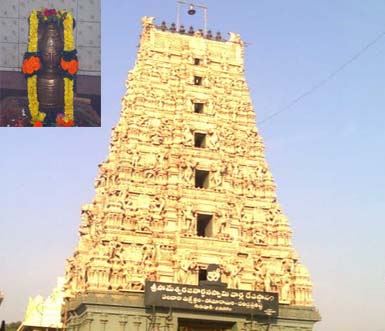Name of the Temple |
- The temple is called Someśhwaraswāmi Ālayam and its Purāṇic name is Soma Rāmam.
|
Location |
- The temple is located in Gunupūdi Bhīmāvaram, West Godavari district of Āndhrapradeśh in South India.
|
| How to reach there? |
- By Air : The nearest airport is Bengalūru International Airport, around 70 km away. Take the National Highway 648 south-east and than the National Highway 75 east to Kōlār
- By Train : The nearest railway station is located in Bangārapéṭ which is 15 km away from Kōlār. From Bangārapéṭ take the State Highway 5 north.
- By Road : Kolār is located 68 km from the city of Bengalūru, on the Chennai-Bengalūru National Highway. It is well connected to almost all major cities and towns in Karnāṭaka and Āndhra Pradeśh.
|
Rulers/builders and Time Period
|
- Bhīmāvaram is famous for the temple of Lord Śhiva that is about 1000 years.
- This was endowed liberally by Bhīma, one of the enlightened rulers of the Chālukya dynasty, during 4th century.
- Later during the Vīraśhaiva rulers of Vunḍi dynasty, the temple became popular when many additions were made and lured Bhakthas in unending streams.
- The same town houses two more Śhivālayas with tall Śhivalingas built and patronized by Chālukyas in the tenth century and they are called Someśhwarālayam and Bhimeśhwarālayam. Their origin is recent when compared with one housing of the big Śhivalinga installed by Soma.
|
Deity/Deities |
- This sacred shrine is dedicated to Maheśhwara.
- The face of Śhiva lingam in this temple is called Sathyojāthamukha Swarūpam.
- The Śhiva lingam is called Someśhwara as it is believed that this lingam has been installed by Lord Chandhra.
|
Architecture Style |
- The temple faces east and has a high charming tower over the Mahādhwār.
- The temple is two storied and enshrines Someśhwaralinga in the ground floor and the image of Mother Pārvathi in the first floor in the name of Annapūrṇa.
- This Śhivalinga was installed by the Moon God-Soma. The crystal linga reflects the waning and waxing of Moon - i.e. appearing bright for fifteen days like the Moon and dim- in the next fortnight. On full moon days it appears white and on new moon days, brown and black.
- Other uniqueness of this temple is that there is a temple of Goddess Annapūrṇa just above the Garbha Gruha of Someśhwara Swāmi, on the first floor.
- In the main manṭapam, there are few steps that lead you to the temple of Annapurna on the first floor. You cannot see this feature in any of the temples in India.
- Another interesting feature of this temple is that there are five Nandhis in front of the Śhiva Lingam unlike in other temples where you find only one or maximum two Nandhis.
- The entrance of the temple is marked by a 15 feet tall pillar.
- To the east of the main temple, there is a "Puṣhkariṇi" (sacred pond) called as "Soma Gunḍam" or "Chandhra Puṣhkariṇi" because it is believed to be created by the Moon God (Chandhrudu in Thelugu).
|
Other Special Features |
- This place is well known for the temple Soma Rāma which is considered as one of the Pancha Rāma temples.
- The archamūrthi Śhivalinga is fairly a big one measuring about five feet in height.
|
Any Other/Remarks |
- The temple here is called Śhrī Someśhwara Janārdhana swāmi. It is one of the Pancha Rāmas sanctified by the falling of one of the five broken chips of Amruthalinga worn by Thārakāsura.
|
Special Reference to Performing Arts |
- Dikṣhithar composed Śhrī Pārthasārathi in Śhuddha dhanyāsi.
- Nearby is the shrine dedicated to Lord Śhiva. Dikṣhithar paid his tribute to the Lord by composing Mārgasahāyeśhwaram in the Rāga Kāshirāmakriya, Maragathavalli in Khāmboji and Nīsāṭi daivamendul Edani Marulukonthira Thelugu Krithi on Śhiva.
|
Bibliography |
|















